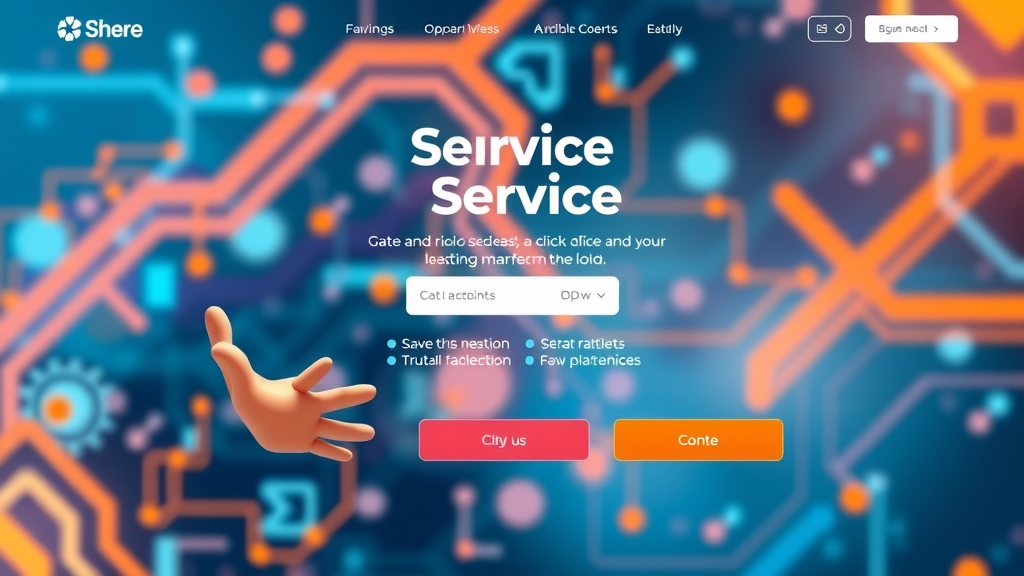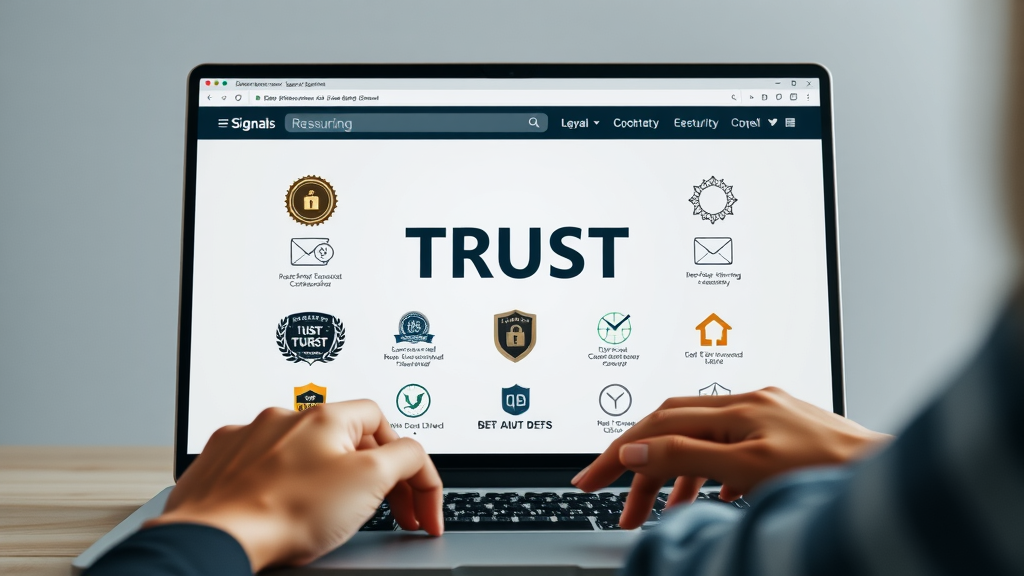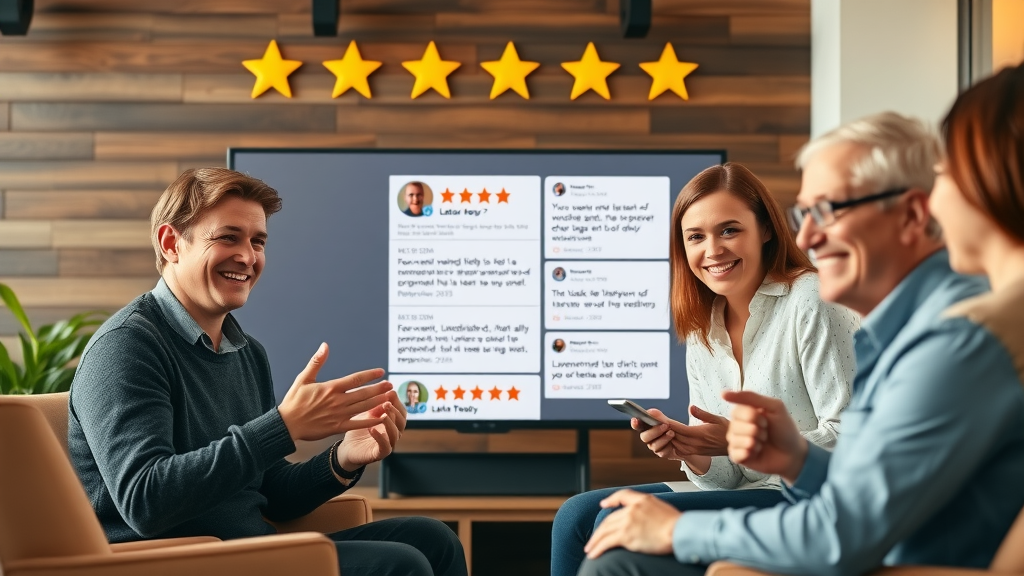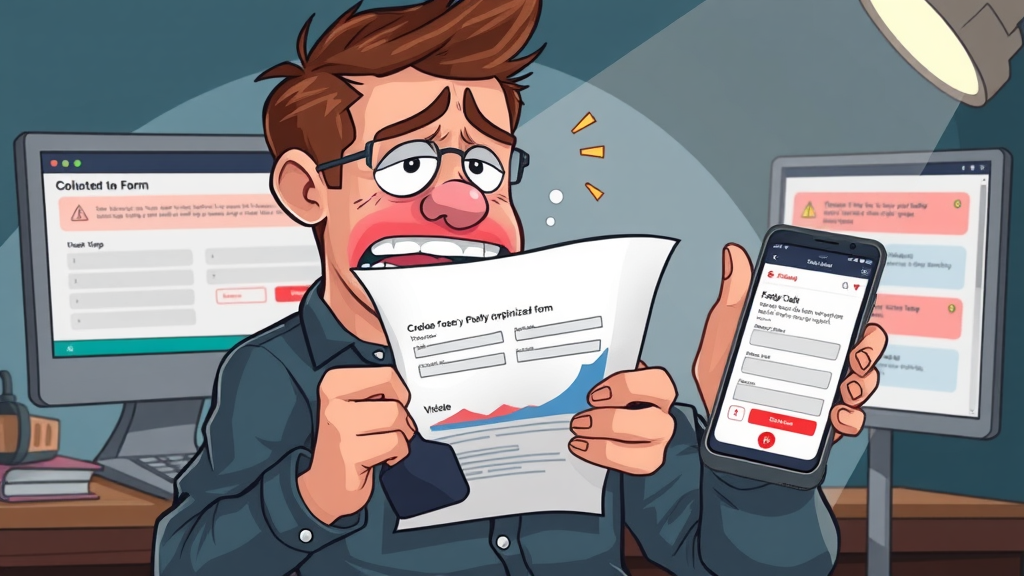- Did you know that nearly 70% of potential leads abandon service business websites due to poor website conversion experiences? Learn how to shift this trend in your favor, improve website conversion rates rapidly, and drive impactful results for your service business.

How to Improve Website Conversions for Service Businesses: Essential First Steps
- Define and understand website conversion goals for your service business, ensuring clarity in measuring conversion rate improvements.

To improve website conversions for service businesses , you must start by establishing clear, measurable goals. A website conversion occurs when a site visitor takes a desired action—such as submitting a contact form, booking a consultation, or calling your business. Begin by defining what a "conversion" means for your specific service business. Is it an appointment booked, a free quote requested, or a newsletter subscription? Knowing this is the first step to understanding your conversion rate.
Once your goals are defined, assess your current conversion rates using web analytics tools. Pinpoint which pages receive the most traffic and where potential customers drop off. Examine your landing page , ensure your call to action (CTA) is clear, and identify any bottlenecks that hinder conversions. With this foundational understanding, you’re primed to move forward with focused, data-driven improvements that directly support your business objectives.
Key Takeaways: Fast-Track Methods for How to Improve Website Conversions for Service Businesses
- Immediate strategies to increase conversion and optimize your service business website and landing page.
- The role of conversion rate optimization, compelling calls to action, and trust-building elements in boosting conversion rates.
The fastest path to increase conversion rates begins with a few proven techniques. First, optimize your landing pages to match visitor intent—aligning your headline and value proposition to the needs of your target audience . Next, ensure your CTAs are visible and irresistible, guiding visitors toward the next step without confusion. Finally, amplify trust by featuring testimonials, trust badges, and transparent business information. Combining these elements results in immediate improvements in your website conversion metrics.
Leveraging conversion rate optimization (CRO) is not just about testing button colors. It's about creating a seamless, intuitive user experience that addresses pain points and removes barriers to action. When your site feels trustworthy and easy to navigate, website visitors are far more likely to convert, driving measurable business growth.
How to Improve Website Conversions for Service Businesses by Optimizing Your Landing Page and Call to Action
Crafting High-Converting Landing Pages for Increased Website Conversion
- Leverage landing page best practices, including value propositions, concise messaging, and prominent calls to action that address user pain points.

Effective landing pages are central to driving website conversions . Begin by articulating a clear, compelling value proposition—a short, benefit-driven statement that tells visitors exactly what makes your service business unique. Support this with concise messaging that speaks directly to your target audience's needs and pain points. A well-designed landing page eliminates distractions, minimizes navigation, and draws the eye to a prominent call to action .
Utilize visual hierarchy by using bold headlines, bullet points, and whitespace to naturally guide users toward your CTA. Ensure that each landing page is laser-focused on a single goal to prevent confusion. For example, if the intent is to book a consultation, your CTA should read "Book Your Free Consultation Now" and be placed above the fold. Maintaining a cohesive look—aligned with your branding—also helps build trust and boosts conversion rates .
Call to Action Tactics: How to Increase Conversion Rate for Service Businesses
- Examples of effective calls to action that drive website visitors to convert. Place multiple calls to action (CTAs) naturally across landing pages.
Your CTAs should be action-oriented, benefit-focused, and easy to locate. Avoid generic phrases like "Submit" in favor of CTAs like "Get My Free Quote," "Schedule a Call Today," or "Unlock My Exclusive Offer." Place your primary CTA above the fold but also include secondary CTAs throughout your landing page to catch returning visitors or those ready to act after reading more information.
Test CTA placement, wording, and color for maximum effect—a minor change can greatly increase your conversion rate . Remember, multiple CTAs aren’t about overwhelming the visitor, but about ensuring a clear next step is always within reach. For service businesses, combining urgency triggers (e.g., "Limited Spots Left") with risk-reversal statements (e.g., "No Obligation, Cancel Anytime") can further motivate hesitant users to take action.
"A well-optimized landing page can increase your conversion rate by up to 50%." – Marketing Research Report
Understanding Conversion Rate and Conversion Rate Optimization for Service Businesses
- What is conversion rate and why is conversion rate optimization critical for website conversion success in service industries?

Conversion rate is the percentage of website visitors who take a desired action, such as filling out a form, requesting a quote, or calling your business. In the service industry, even a small boost in your average conversion rate can translate to significantly more leads and revenue. Understanding and tracking your baseline conversion metrics is crucial to identifying improvement opportunities.
Conversion rate optimization (CRO) is the process of continually testing and improving your website experience to convert more visitors into customers. This involves identifying bottlenecks, reducing friction, and introducing elements like trust signals, fast loading times, and intuitive navigation. When executed correctly, CRO delivers compounding results that fuel steady business growth.
In addition to quantitative data, qualitative insights from heatmaps or on-site surveys uncover why visitors abandon your website. Each test—whether it's tweaking CTA language or simplifying a booking form—serves as a stepping stone on the path to higher conversion and profitability.
Rate Optimization Tactics for Website Conversion
- A/B testing, multivariate testing, and iterative adjustments for higher conversion rates.
Modern rate optimization is all about experimentation. Begin with A/B testing—comparing two versions of a landing page or CTA to see which performs better. You might test button colors, CTA text, or even headline messaging. Multivariate testing lets you test several variables simultaneously to pinpoint which combination offers the greatest lift in conversion rate .
Always make one change at a time and measure results accurately to identify what truly moves the needle. Successful businesses review analytics regularly, double down on strategies that work, and swiftly pivot from underperforming ideas. This cycle of constant improvement is at the heart of conversion rate optimization for service-based websites.
Once you discover high-performing variations, implement them site-wide, and continue testing advanced elements, like interactive chat widgets, trust-building badges, or limited-time offers. Data-driven, iterative refinements ensure that your site doesn’t just convert well—it gets better over time.
Website Visitor Analysis: Improve Website Conversion by Understanding User Behavior
- Utilizing analytics to track website visitors, uncover drop-off points, and refine website conversion strategies.

Comprehensive website visitor analysis arms your business with actionable insights. Analytics tools like Google Analytics, Hotjar, and Crazy Egg display exactly how visitors interact with your pages—where they linger, where they hesitate, and where they exit. By spotlighting drop-off points, you can tackle the obstacles hampering your website conversion .
Start by analyzing top exit pages and high-bounce rate content. Do visitors abandon your site on mobile? Is a lengthy form deterring sign-ups? Or does a missing CTA create confusion? Fixing these pain points can lead to a dramatic improvement in your conversion rates . Use real user journeys and feedback to personalize experiences, smooth the conversion funnel, and ensure that every website visitor ends up closer to becoming a customer.
Segmenting Your Target Audience for Higher Website Conversion Rates
- Custom user experiences, targeting website visitors' pain points, and building trust through personalization.
Not every website visitor is the same—segmenting your target audience allows you to personalize landing page content for different personas. For example, new visitors might need detailed service explanations, while returning visitors might simply want a quick booking option or special offer.
Use data such as location, device, traffic source, or user behavior to present relevant offers and content. Dynamic text replacement, custom videos, and audience-specific testimonials build trust and resonate with each group’s unique needs. The more relevant your site feels, the higher your conversion rates climb.
Segmentation also allows you to run targeted remarketing and email campaigns, ensuring each potential customer progresses through the buying journey in a way that fits their needs.
User Experience: The Foundation for Conversion Rates and Conversion Rate Optimization
- How seamless user experience, intuitive navigation, and minimized friction drive website conversion.

An exceptional user experience (UX) is the cornerstone of all high-performing service business websites. When users can intuitively find what they're looking for—whether that's a pricing page, contact form, or FAQ—they’re far more likely to convert. Streamline site navigation, use descriptive menu labels, and make essential information just one or two clicks away from any entry point.
Eliminate friction points: minimize the number of form fields, enable autofill where possible, and make sure your site loads rapidly, especially for mobile users. A clutter-free, visually appealing web design instills confidence and encourages action. Every improvement in usability directly supports both higher conversion rates and stronger customer loyalty.
Visual Design and Trust Signals to Increase Conversion
- Incorporate trust badges, professional design, and quick loading times to increase conversion and grow your business.
| Element | Why It Matters | Quick Improvements |
|---|---|---|
| Value Proposition | Clarifies your offer and benefits for rapid understanding | Write a bold, benefit-focused heading at the top of your landing page |
| Call to Action | Guides users to convert | Use buttons with active language like "Get My Free Quote" |
| Trust Signals | Builds credibility and reduces anxiety | Add SSL, client logos, testimonials, and accreditations near CTAs |
| Mobile Optimization | Captures conversions from mobile device users | Ensure all forms & buttons are large, clear, and thumb-friendly |
| Fast Load Time | Reduces bounce rate and increases conversions | Optimize images, enable caching, and use a content delivery network (CDN) |

Social Proof: Leveraging Reviews and Testimonials to Build Trust and Website Conversion
- Showcase client testimonials, ratings, reviews, and social media mentions on your landing pages to build trust and increase your conversion rate.

Social proof is a psychological catalyst for website conversions. When website visitors see real testimonials, authentic ratings, or industry awards featured prominently, they’re reassured that your service business is credible and delivers on its promises. Embed customer success stories, client logos, and case studies across your website and landing pages to increase trust.
Highlight positive reviews from platforms like Google, Yelp, or social media, and supplement them with star ratings and before-and-after results where possible. Real-time activity indicators ("5 people requested a quote today") also create a sense of community and urgency, motivating fence-sitters to act now.
List: Top Social Proof Strategies for Service Business Website Conversion
- Display customer testimonials
- Show real-time social media activity
- Feature business accreditations and industry awards
How to Improve Website Conversions for Service Businesses: Addressing Common Pain Points
- Remove barriers to conversion by highlighting solutions for common pain points such as unclear offers, slow response times, and lack of trust signals.

Common pain points on service business websites include vague offers, lengthy forms, hard-to-find contact options, and slow response times. These issues create confusion and mistrust, causing potential customers to look elsewhere. Address each one by clarifying your value proposition, being upfront with pricing or next steps, and offering multiple, clearly marked ways to get in touch.
A fast, friendly live chat or callback option resolves concerns in real time and demonstrates that your business is responsive and customer-centric. Place trust badges and accreditations near booking forms to boost confidence at the decision-making moment, and confirm appointment requests immediately with automated emails or texts.
Addressing Pain Points in Landing Pages and Calls to Action
- Clarify your offer, simplify the booking process, and provide clear, risk-free calls to action.
Eliminate jargon, explain exactly what will happen after a website visitor fills out a form, and keep the process as short and reassuring as possible. Use risk-reducing terms such as "No obligation," "Cancel anytime," or "100% satisfaction guarantee" alongside your calls to action to further build trust with hesitant customers.
How to Improve Website Conversions for Service Businesses with Retargeting and Follow-Up Campaigns
- Implement email follow-ups, on-site retargeting, and remarketing ads to re-engage website visitors and increase your conversion rate.

Most website visitors don’t convert on their first visit. To capture these lost opportunities, deploy automated retargeting campaigns. Use on-site pop-ups to re-capture abandoning users ("Wait! Get a free consultation if you book now!"), and follow up with targeted email sequences that reinforce your value proposition and include fresh CTAs.
Launch remarketing ads on platforms like Google and Facebook to stay top-of-mind for warm leads, driving them back to your landing page when they're ready to book. Consistent, personalized follow-up is key to increase conversion rate for any service business, turning browsers into buyers even after they’ve left your site.
People Also Ask: Strategies and Tips for Improving Website Conversion Rates in Service Businesses
How can I improve my website conversion rate?
- Improve clarity of your call to action, optimize your landing page, personalize user experience and implement conversion rate optimization best practices.
To improve your website conversion rate, start by refining your landing page and calls to action for maximum clarity. Ensure your CTAs are visible, action-oriented, and tailored to your service’s value. Personalize the user experience using segmentation, heatmaps, and analytics to remove obstacles in the visitor journey. Continually test and implement proven conversion rate optimization techniques for consistent growth.
What are the 6 primary elements of conversion rate optimization?
- Landing page design
- Value proposition
- Calls to action
- User experience
- Trust signals
- Data-driven rate optimization
Conversion rate optimization is built on six pillars: a focused landing page design, a compelling value proposition, powerful calls to action, intuitive user experience, prominent trust signals, and consistent reliance on analytics to guide decisions. By strengthening each of these elements, your service business can greatly increase conversion rates and overall sales success.
What are three actions that can improve your conversion rate?
- 1. A/B test landing pages
- 2. Simplify forms and calls to action
- 3. Build trust using social proof and testimonials
Three impactful actions are: A/B testing your landing pages to identify the most effective designs, simplifying all forms and CTAs to make conversions quick and easy, and adding social proof such as testimonials and badges throughout your site. Doing so helps reduce friction, prove credibility, and quickly build trust with your target audience.
How to increase CRO (conversion rate optimization)?
- Analyze user behavior, test and refine landing pages, update calls to action and continuously monitor results for ongoing improvements.
To increase CRO, thoroughly analyze how users interact with your website. Use the data to test and refine every element of your landing pages and CTAs. Update content based on what resonates most, and never stop measuring the results—continuous improvement is the key to sustained conversion rate gains.
List: Common Mistakes Service Businesses Make That Harm Website Conversion
- Neglecting mobile experience
- Overcomplicating forms
- Weak or missing calls to action
- Failing to use social proof
- Poor design hurting conversion rates

Avoid these frequent conversion killers: not optimizing for mobile users, asking for too much information up front, using weak CTAs, failing to showcase social proof, and neglecting the professional design of your website. Each misstep erodes trust and frustrates visitors, sabotaging your chance to convert valuable traffic into real business. Regularly auditing your site and fixing these areas results in immediate improvements in conversion rates.
FAQs: How to Improve Website Conversions for Service Businesses
- How often should I update my landing page?
- Which metrics matter most for rate optimization?
- What is a good conversion rate benchmark for service businesses?
- Can social media influence website conversion rates?
How often should I update my landing page? Review your landing page monthly to spot performance drops. Significant updates are recommended after every major service offering change, branding refresh, or when analytics show a decline in conversion rate. A/B testing new headlines or CTAs, and gathering direct feedback, can guide the timing of content improvements.
Which metrics matter most for rate optimization? Focus on your overall conversion rate, bounce rate, average time on page, and form completion rate. Also track cost per lead, traffic sources, and mobile vs. desktop conversions. These data points guide you to the highest-impact optimization opportunities.
What is a good conversion rate benchmark for service businesses? While the average conversion rate varies by industry, service businesses typically see a rate between 2% and 5%. Top performers, however, can achieve 10% or higher with best practices in landing page design, calls to action, and trust-building strategies.
Can social media influence website conversion rates? Absolutely. Social media channels can drive targeted, intent-rich traffic to your landing pages and magnify social proof by showcasing customer experiences and reviews. Engaged, well-targeted social audiences typically convert at a higher rate than cold website traffic.
Summary: Results You Can Expect with Structured Conversion Rate Optimization
- Progressively increase your conversion rate, boost website conversions, and experience measurable business growth by applying these tried-and-tested strategies.
"Conversion rate optimization is about understanding your website visitor at every step – then serving their needs without friction." – Conversion Expert
Next Steps: How to Improve Website Conversions for Service Businesses and Grow Your Business
- Ready to grow your business? Book your free Marketing Strategy Session at https://imodagency1.com or call 5626207576.
Act quickly: audit your landing page, refine your call to action, embrace analytics, and integrate trust signals—then watch your conversions soar. Need hands-on support? Book your free Marketing Strategy Session now .
To further enhance your understanding of improving website conversions for service businesses, consider exploring the following resources:
- “7 Simple Ways To Increase Your Website Conversion Rate” ( forbes.com )
This article outlines straightforward strategies, such as optimizing website navigation and utilizing compelling call-to-action buttons, to effectively boost conversion rates.
- “17 Ways to Improve Your Website Conversion Rate” ( adaglobal.com )
This resource provides a comprehensive list of techniques, including enhancing page load speed and implementing live chat support, to improve user experience and increase conversions.
By delving into these articles, you’ll gain actionable insights and practical tips to optimize your service business website for higher conversion rates.
 Add Row
Add Row  Add
Add 




Write A Comment